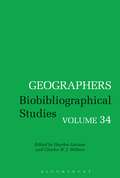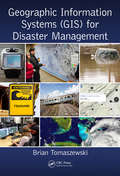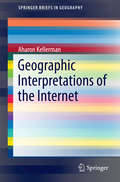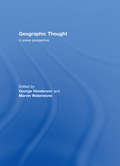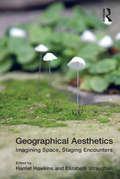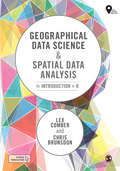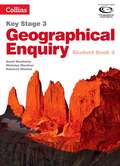- Table View
- List View
Geographers: Biobibliographical Studies, Volume 35 (Geographers #26)
by Hayden Lorimer Charles W. WithersGeographers: Biobibliographical Studies, Volume 35 includes seven essays discussing the contribution made to geography by eleven geographers. The subjects include: three British figures, Francis Rennell Rodd (1895-1978) expert on the Sahara; David Harris (1930-2013), a geographer with archaeological interests; and William Gordon East, historical geographer (1902-1998); a Spanish urban scholar, Enric Martin (1928-2012); Mauricio de Almeida Abreu (1948-2011), a Brazilian urban and historical geographer; and two essays on French geographers, one on Jacques Levainville (1869-1932), the other an innovative prosopographical essay on five French authors involved in the monumental Vidalian Geographie Universelle of the early 20th century. In these studies, geography's international dimensions are illuminated and the subject's vibrant history shown to be the result of committed endeavours in the field, in the classroom and in print.
Geographers: Biobibliographical Studies, Volume 34 (Geographers #26)
by Hayden Lorimer Charles W. J. WithersVolume 34 of Geographers: Biobibliographical Studies features eight essays that together demonstrate geographers' diverse scholarly engagement with the practise of their subject. There are two physical geographers (a Frenchman and an Englishman, both geomorphologists), a British historical geographer, a French colonial geographer, a Russian explorer-naturalist of Central Asia and Tibet, a British-born but long-time Australian resident and scholar of India, Pakistan, and the Pacific world, an American regionalist and eugenicist, and a Scots-born long-time American resident, one of the world's leading Marxist geographers and urban theorists. Equally but differently committed to geography's many specialisms, these subjects wonderfully illuminate the vibrancy – and the contradictions – behind the living of geographical lives.
Geographic Data Science with Python (Chapman & Hall/CRC Texts in Statistical Science)
by Sergio Rey Dani Arribas-Bel Levi John WolfThis book provides the tools, the methods, and the theory to meet the challenges of contemporary data science applied to geographic problems and data. In the new world of pervasive, large, frequent, and rapid data, there are new opportunities to understand and analyze the role of geography in everyday life. Geographic Data Science with Python introduces a new way of thinking about analysis, by using geographical and computational reasoning, it shows the reader how to unlock new insights hidden within data. Key Features: ● Showcases the excellent data science environment in Python. ● Provides examples for readers to replicate, adapt, extend, and improve. ● Covers the crucial knowledge needed by geographic data scientists. It presents concepts in a far more geographic way than competing textbooks, covering spatial data, mapping, and spatial statistics whilst covering concepts, such as clusters and outliers, as geographic concepts. Intended for data scientists, GIScientists, and geographers, the material provided in this book is of interest due to the manner in which it presents geospatial data, methods, tools, and practices in this new field.
Geographic Data Science with Python (Chapman & Hall/CRC Texts in Statistical Science)
by Sergio Rey Dani Arribas-Bel Levi John WolfThis book provides the tools, the methods, and the theory to meet the challenges of contemporary data science applied to geographic problems and data. In the new world of pervasive, large, frequent, and rapid data, there are new opportunities to understand and analyze the role of geography in everyday life. Geographic Data Science with Python introduces a new way of thinking about analysis, by using geographical and computational reasoning, it shows the reader how to unlock new insights hidden within data. Key Features: ● Showcases the excellent data science environment in Python. ● Provides examples for readers to replicate, adapt, extend, and improve. ● Covers the crucial knowledge needed by geographic data scientists. It presents concepts in a far more geographic way than competing textbooks, covering spatial data, mapping, and spatial statistics whilst covering concepts, such as clusters and outliers, as geographic concepts. Intended for data scientists, GIScientists, and geographers, the material provided in this book is of interest due to the manner in which it presents geospatial data, methods, tools, and practices in this new field.
Geographic Information Science and Public Participation (Advances in Geographic Information Science)
by Laxmi RamasubramanianComputer-mediated participation is at the crossroads. In the early heady days of the digital revolution, access to "high" technologies such as GIS promised the empowerment of marginalized communities by providing data and information that was previously hidden away from public view. To a great extent, this goal has been achieved at least in the U.S. and Western Europe – data about a range of government initiatives and raw data about different aspects of spatial planning such as land use, community facilities, property ownership are available a mouse-click away. Now, that we, the public, have access to information, are we able to make better plans for the future of our cities and regions? Are we more inclusive in our planning efforts? Are we able to foster collaborative governance structures mediated by digital technologies? In the book, these issues will be discussed using a three-part structure. The first part of the book will be theoretical – it will review the literature in the field, establish a framework to organize the literature and to link three different subject areas (participation and community development, GIS and other related technologies, and planning processes). The second part of the book will be a series of success stories, case studies that review actual situations where participatory planning using GIS has enabled community wellbeing and empowerment. These case studies will vary in scale and focus on different planning issues (planning broadly defined). The final part of the book will step back to review alternative scenarios for the future, exploring where we are headed, as the technologies we are using to plan rapidly change.
Geographic Information Systems: Socioeconomic Applications
by David MartinThis second edition of Geographic Information Systems builds on the strengths of the first, and incorporates important recent advances in GIS development and major new socioeconomic datasets including new census data. Martin presents an accessible introduction to the history, principles and techniques of GIS, with a unique focus on socioeconomic applications. This non-technical volume addresses the needs of students and professionals who must understand and use GIS for the first time.
Geographic Information Systems: Socioeconomic Applications
by David MartinThis second edition of Geographic Information Systems builds on the strengths of the first, and incorporates important recent advances in GIS development and major new socioeconomic datasets including new census data. Martin presents an accessible introduction to the history, principles and techniques of GIS, with a unique focus on socioeconomic applications. This non-technical volume addresses the needs of students and professionals who must understand and use GIS for the first time.
Geographic Information Systems (GIS) for Disaster Management
by Brian TomaszewskiGeographic Information Systems (GIS) provide essential disaster management decision support and analytical capabilities. As such, homeland security professionals would greatly benefit from an interdisciplinary understanding of GIS and how GIS relates to disaster management, policy, and practice. Assuming no prior knowledge in GIS and/or disaster ma
Geographic Information Systems (GIS) for Disaster Management
by Brian TomaszewskiNow in its second edition, Geographic Information Systems (GIS) for Disaster Management has been completely updated to take account of new developments in the field. Using a hands-on approach grounded in relevant GIS and disaster management theory and practice, this textbook continues the tradition of the benchmark first edition, providing coverage of GIS fundamentals applied to disaster management. Real-life case studies demonstrate GIS concepts and their applicability to the full disaster management cycle. The learning-by-example approach helps readers see how GIS for disaster management operates at local, state, national, and international scales through government, the private sector, non‐governmental organizations, and volunteer groups. New in the second edition: a chapter on allied technologies that includes remote sensing, Global Positioning Systems (GPS), indoor navigation, and Unmanned Aerial Systems (UAS); thirteen new technical exercises that supplement theoretical and practical chapter discussions and fully reinforce concepts learned; enhanced boxed text and other pedagogical features to give readers even more practical advice; examination of new forms of world‐wide disaster faced by society; discussion of new commercial and open-source GIS technology and techniques such as machine learning and the Internet of Things; new interviews with subject-matter and industry experts on GIS for disaster management in the US and abroad; new career advice on getting a first job in the industry. Learned yet accessible, Geographic Information Systems (GIS) for Disaster Management continues to be a valuable teaching tool for undergraduate and graduate instructors in the disaster management and GIS fields, as well as disaster management and humanitarian professionals. Please visit http://gisfordisastermanagement.com to view supplemental material such as slides and hands-on exercise video walkthroughs. This companion website offers valuable hands-on experience applying concepts to practice.
Geographic Information Systems (GIS) for Disaster Management
by Brian TomaszewskiNow in its second edition, Geographic Information Systems (GIS) for Disaster Management has been completely updated to take account of new developments in the field. Using a hands-on approach grounded in relevant GIS and disaster management theory and practice, this textbook continues the tradition of the benchmark first edition, providing coverage of GIS fundamentals applied to disaster management. Real-life case studies demonstrate GIS concepts and their applicability to the full disaster management cycle. The learning-by-example approach helps readers see how GIS for disaster management operates at local, state, national, and international scales through government, the private sector, non‐governmental organizations, and volunteer groups. New in the second edition: a chapter on allied technologies that includes remote sensing, Global Positioning Systems (GPS), indoor navigation, and Unmanned Aerial Systems (UAS); thirteen new technical exercises that supplement theoretical and practical chapter discussions and fully reinforce concepts learned; enhanced boxed text and other pedagogical features to give readers even more practical advice; examination of new forms of world‐wide disaster faced by society; discussion of new commercial and open-source GIS technology and techniques such as machine learning and the Internet of Things; new interviews with subject-matter and industry experts on GIS for disaster management in the US and abroad; new career advice on getting a first job in the industry. Learned yet accessible, Geographic Information Systems (GIS) for Disaster Management continues to be a valuable teaching tool for undergraduate and graduate instructors in the disaster management and GIS fields, as well as disaster management and humanitarian professionals. Please visit http://gisfordisastermanagement.com to view supplemental material such as slides and hands-on exercise video walkthroughs. This companion website offers valuable hands-on experience applying concepts to practice.
Geographic Interpretations of the Internet (SpringerBriefs in Geography)
by Aharon KellermanThis book introduces the Internet through a systematic geographical interpretation, thus shedding light on the Internet as a spatial entity. The book’s approach is to extend basic concepts developed for terrestrial geography to cyberspace, most notably those relating to space, structure, place, distance, mobility, and presence. It further considers the Internet by its constitution of information space, communications space, and screen space. By using well-known concepts from traditional human geography, this book proposes a combination of terrestrial and virtual geographies, which may in turn help in coping with Internet structures and contents. The book appeals to human and economic geographers, especially those interested in information and Internet geographies. It may also be of special interest and importance to sociologists and media scholars and students dealing with communication technology and the Internet.
Geographic Perspectives on Soviet Central Asia
by Robert LewisIn a unique survey, based on new census data, Geographic Perspectives on Soviet Central Asia highlights the region's geographic, economic and ecological problems since 1945. Painting a grim picture, this book investigates how the combination of rapid population growth and declining per capita investment is causing economic conditions to slide in rural areas and encouraging an ecological catastrophe. The authors discuss the effects of low rural out-migration, and show that at current growth rates the rural working-age population will double with each generation. Unprecedented in a developed country, this is causing the region to become more rather than less rural. Soviet Central Asia is an area of low productivity, and the book considers the lack of support from Soviet central government to the region. Wishing to maximise their return to capital and labour, the government is concentrating its investment in the European West and directing insufficient funds for a growing workforce in Central Asia. Soviet Central Asia also faces grave ecological problems; the declining level of the Aral Sea, extensive soil salinization and water pollution, all largely due to past attempts at irrigation. The authors consider the effect of these disasters on the area, and look to future possibilities in this very important region of the world.
Geographic Perspectives on Soviet Central Asia
by Robert A. LewisIn a unique survey, based on new census data, Geographic Perspectives on Soviet Central Asia highlights the region's geographic, economic and ecological problems since 1945. Painting a grim picture, this book investigates how the combination of rapid population growth and declining per capita investment is causing economic conditions to slide in rural areas and encouraging an ecological catastrophe. The authors discuss the effects of low rural out-migration, and show that at current growth rates the rural working-age population will double with each generation. Unprecedented in a developed country, this is causing the region to become more rather than less rural. Soviet Central Asia is an area of low productivity, and the book considers the lack of support from Soviet central government to the region. Wishing to maximise their return to capital and labour, the government is concentrating its investment in the European West and directing insufficient funds for a growing workforce in Central Asia. Soviet Central Asia also faces grave ecological problems; the declining level of the Aral Sea, extensive soil salinization and water pollution, all largely due to past attempts at irrigation. The authors consider the effect of these disasters on the area, and look to future possibilities in this very important region of the world.
Geographic Thought: A Critical Introduction (Critical Introductions to Geography)
by Tim CresswellThis engaging and accessible introduction to geographic thought explores the major thinkers and key theoretical developments in the field of human geography. Covers the complete range of the development of theoretical knowledge of the field, from ancient geography to contemporary non-representational theory Presents theories in an accessible manner through the author's engaging writing style Examines the influence of Darwin and Marx, the emergence of anarchist geographies, the impact of feminism, and myriad other important bodies of thought Stresses the importance of geographic thought and its relevance to our understanding of what it is to be human, and to the people, places, and cultures of the world in which we live
Geographic Thought: A Critical Introduction (Critical Introductions to Geography)
by Tim CresswellThis engaging and accessible introduction to geographic thought explores the major thinkers and key theoretical developments in the field of human geography. Covers the complete range of the development of theoretical knowledge of the field, from ancient geography to contemporary non-representational theory Presents theories in an accessible manner through the author's engaging writing style Examines the influence of Darwin and Marx, the emergence of anarchist geographies, the impact of feminism, and myriad other important bodies of thought Stresses the importance of geographic thought and its relevance to our understanding of what it is to be human, and to the people, places, and cultures of the world in which we live
Geographic Thought: A Praxis Perspective
by George Henderson Marvin WaterstoneWithout social movements and wider struggles for progressive social change, the field of Geography would lack much of its contemporary relevance and vibrancy. Moreover, these struggles and the geographical scholarship that engages with them have changed the philosophical underpinnings of the discipline and have inflected the quest for geographical knowledge with a sense not only of urgency but also hope. This reader, intended for advanced undergraduate and beginning graduate courses in Geographic Thought, is at once an analysis of Geography’s theoretical and practical concerns and an encounter with grounded political struggles. This reader offers a fresh approach to learning about Geographic Thought by showing, through concrete examples and detailed editorial essays, how the discipline has been forever altered by the rise of progressive social struggles. Structured to aid student understanding, the anthology presents substantive main and part introductory essays and features more than two dozen unabridged published works by leading scholars that emphatically articulate geographic thought to progressive social change. Each section is introduced with an explanation of how the following pieces fit into the broader context of geographic work amidst the socially progressive struggles that have altered social relations in various parts of the world over the last half-century or so. Doubly, it places this work in the context of the larger goals of social struggles to frame or reframe rights, justice, and ethics. Geographic Thought provides readers with insights into the encounters between scholarship and practice and aims to prompt debates over how social and geographical knowledges arise from the context of social struggles and how these knowledges might be redirected at those contexts in constructive, evaluative ways. The reader is unique not only in knowing Geographic Thought through its progressive political attachments, instead of through a series of abstract "isms", but in gathering together salient works by geographers as well as scholars in cognate fields, such as Nancy Fraser, Chantal Mouffe, Iris Marion Young, and Jack Kloppenberg, whose own engagements have proved lasting and influential. For researchers and students interested in the connections between theoretically informed work and the possibilities for bettering people’s everyday lives, this book provides an innovative and compelling argument for why Geographic Thought is valuable and necessary.
Geographical Aesthetics: Imagining Space, Staging Encounters
by Elizabeth StraughanGeographical Aesthetics places the terms 'aesthetics' and 'geography' under critical question together, responding both to the increasing calls from within geography to develop a 'geographical aesthetics', and a resurgence of interdisciplinary interest in conceptual and empirical questions around geoaesthetics, environmental aesthetics, as well as the spatialities of the aesthetic. Despite taking up an identifiable role within the geographical imagination and sensibilities for centuries, and having what is arguably a key place in the making of the modern discipline, aesthetics remains a relatively under-theorized field within geography. Across 15 chapters Geographical Aesthetics brings together timely commentaries by international, interdisciplinary scholars to rework historical relations between geography and aesthetics, and reconsider how it is we might understand aesthetics. In renewing aesthetics as a site of investigation, but also an analytic object through which we can think about worldly encounters, Geographical Aesthetics presents a reworking of our geographical imaginary of the aesthetic.
Geographical Aesthetics: Imagining Space, Staging Encounters
by Elizabeth StraughanGeographical Aesthetics places the terms 'aesthetics' and 'geography' under critical question together, responding both to the increasing calls from within geography to develop a 'geographical aesthetics', and a resurgence of interdisciplinary interest in conceptual and empirical questions around geoaesthetics, environmental aesthetics, as well as the spatialities of the aesthetic. Despite taking up an identifiable role within the geographical imagination and sensibilities for centuries, and having what is arguably a key place in the making of the modern discipline, aesthetics remains a relatively under-theorized field within geography. Across 15 chapters Geographical Aesthetics brings together timely commentaries by international, interdisciplinary scholars to rework historical relations between geography and aesthetics, and reconsider how it is we might understand aesthetics. In renewing aesthetics as a site of investigation, but also an analytic object through which we can think about worldly encounters, Geographical Aesthetics presents a reworking of our geographical imaginary of the aesthetic.
A Geographical Century: Essays for the Centenary of the International Geographical Union
by Vladimir Kolosov Jacobo García-Álvarez Michael Heffernan Bruno SchelhaasThis volume of specially commissioned interpretative essays marks the centenary of the establishment of the International Geographical Union in 1922. Written by leading human and physical geographers from all parts of the world, A Geographical Century considers the history and present condition of geography as an international science. Based on the latest research, A Geographical Century provides new and critical analyses of the different forms of geographical internationalism that emerged during the 20th century; the changing relations between geography and cognate disciplines in the natural and social sciences; the geopolitics of international geographical collaboration; and the prospects of geography as a 21st century international science.
Geographical Data Science and Spatial Data Analysis: An Introduction in R (Spatial Analytics and GIS)
by Chris Brunsdon Lex ComberWe are in an age of big data where all of our everyday interactions and transactions generate data. Much of this data is spatial – it is collected some-where – and identifying analytical insight from trends and patterns in these increasing rich digital footprints presents a number of challenges. Whilst other books describe different flavours of Data Analytics in R and other programming languages, there are none that consider Spatial Data (i.e. the location attached to data), or that consider issues of inference, linking Big Data, Geography, GIS, Mapping and Spatial Analytics. This is a ‘learning by doing’ textbook, building on the previous book by the same authors, An Introduction to R for Spatial Analysis and Mapping. It details the theoretical issues in analyses of Big Spatial Data and developing practical skills in the reader for addressing these with confidence.
Geographical Data Science and Spatial Data Analysis: An Introduction in R (Spatial Analytics and GIS)
by Chris Brunsdon Lex ComberWe are in an age of big data where all of our everyday interactions and transactions generate data. Much of this data is spatial – it is collected some-where – and identifying analytical insight from trends and patterns in these increasing rich digital footprints presents a number of challenges. Whilst other books describe different flavours of Data Analytics in R and other programming languages, there are none that consider Spatial Data (i.e. the location attached to data), or that consider issues of inference, linking Big Data, Geography, GIS, Mapping and Spatial Analytics. This is a ‘learning by doing’ textbook, building on the previous book by the same authors, An Introduction to R for Spatial Analysis and Mapping. It details the theoretical issues in analyses of Big Spatial Data and developing practical skills in the reader for addressing these with confidence.
Geographical Data Science and Spatial Data Analysis: An Introduction in R (Spatial Analytics and GIS)
by Chris Brunsdon Lex ComberWe are in an age of big data where all of our everyday interactions and transactions generate data. Much of this data is spatial – it is collected some-where – and identifying analytical insight from trends and patterns in these increasing rich digital footprints presents a number of challenges. Whilst other books describe different flavours of Data Analytics in R and other programming languages, there are none that consider Spatial Data (i.e. the location attached to data), or that consider issues of inference, linking Big Data, Geography, GIS, Mapping and Spatial Analytics. This is a ‘learning by doing’ textbook, building on the previous book by the same authors, An Introduction to R for Spatial Analysis and Mapping. It details the theoretical issues in analyses of Big Spatial Data and developing practical skills in the reader for addressing these with confidence.
Geographical Enquiry Student Book 3 (PDF)
by David Weatherly Nicholas Sheehan and Rebecca KitchenFocusing on skills development – geographical, PLTS and functional – this book takes a lively and innovative approach to KS3 Geography.Building further on the skills, knowledge and subject understanding of Pupil Books 1 and 2, Pupil Book 3 contains rich tasks and activities which will thoroughly prepare pupils for GCSE Geography. Pupil book enquiries are ‘How’ and ‘Why’ questions consisting of one overarching investigative question and a series of sub questions. Enquiries are supported by teacher resources that provide a clear steer in terms of approaches to learning and teaching and the generation of meaningful outcomes. These outcomes will be easily cross referenced to any national assessment requirements.
Geographical Gerontology: Perspectives, Concepts, Approaches (Routledge Studies in Human Geography)
by Mark W. Skinner Gavin J. Andrews Malcolm P. CutchinUnderstanding where ageing occurs, how it is experienced by different people in different places, and in what ways it is transforming our communities, economies and societies at all levels has become crucial for the development of informed research, policy and programmes. This book focuses on the interdisciplinary field of study – geographical gerontology – that addresses these issues. With contributions from more than 30 leading geographers and gerontologists, the book examines the scope and depth of geographical perspectives, concepts and approaches applied to the study of ageing, old age and older populations. The book features 25 chapters organized into five parts that cover the field’s theoretical traditions and intellectual evolution; the contributions of key disciplinary perspectives from population geography, social and cultural geography, health geography, urban planning and environmental studies; the scales of inquiry within geographical gerontology from the global to the embodied; the thematic breadth of contemporary issues of interest that define the field (places, spaces and landscapes of ageing); and a discussion about challenges, opportunities and agendas for future developments in geography and gerontology. This book provides the first comprehensive foundation of knowledge about the state of the art of geographical gerontology that will be of interest to scholars of ageing around the world.
Geographical Gerontology: Perspectives, Concepts, Approaches (Routledge Studies in Human Geography)
by Mark W. Skinner Gavin J. Andrews Malcolm P. CutchinUnderstanding where ageing occurs, how it is experienced by different people in different places, and in what ways it is transforming our communities, economies and societies at all levels has become crucial for the development of informed research, policy and programmes. This book focuses on the interdisciplinary field of study – geographical gerontology – that addresses these issues. With contributions from more than 30 leading geographers and gerontologists, the book examines the scope and depth of geographical perspectives, concepts and approaches applied to the study of ageing, old age and older populations. The book features 25 chapters organized into five parts that cover the field’s theoretical traditions and intellectual evolution; the contributions of key disciplinary perspectives from population geography, social and cultural geography, health geography, urban planning and environmental studies; the scales of inquiry within geographical gerontology from the global to the embodied; the thematic breadth of contemporary issues of interest that define the field (places, spaces and landscapes of ageing); and a discussion about challenges, opportunities and agendas for future developments in geography and gerontology. This book provides the first comprehensive foundation of knowledge about the state of the art of geographical gerontology that will be of interest to scholars of ageing around the world.

